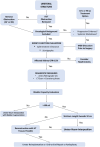Ureter-ileum-interposition: Combined experience from two high-volume centres
- PMID: 39416761
- PMCID: PMC11479808
- DOI: 10.1002/bco2.434
Ureter-ileum-interposition: Combined experience from two high-volume centres
Erratum in
-
Erratum.BJUI Compass. 2024 Dec 30;5(12):1324-1329. doi: 10.1002/bco2.482. eCollection 2024 Dec. BJUI Compass. 2024. PMID: 39744071 Free PMC article.
Abstract
The current study aimed to evaluate short- and long-term complication rates and functional outcomes in a substantial cohort of patients undergoing ileal ureter interposition at two high-volume medical centres.
Materials and methods: A retrospective single-arm analysis was conducted on patients who underwent ureter reconstruction using ileum between 2003 and 2022 at the University Clinic of Cologne and the National Cancer Institute of Ukraine. Data on aetiology, surgical techniques, pre- and postoperative kidney function changes, readmission rates and complication management were collected. Postoperative complications were classified according to Clavien-Dindo, and estimated glomerular filtration rate (eGFR) was calculated using the CKD-EPI formula.
Results: Results revealed 107 cases with consistent data. Within 90 days post-surgery, 53% experienced complications, mainly graded as I-II. Grade III complications were seen in 13%, with two cases of grade IV complications leading to extended hospitalisation and patient death. The 90-day mortality rate was 1.8%. Over a mean follow-up of 52 months, clinically significant vesico-renal refluxes occurred in 28%, with only 5.4% leading to persistent urinary tract infection. Antireflux techniques appeared to reduce urine upflow incidence compared with conventional interposition. Anastomosis stricture occurred in 15% of patients, with 63% requiring permanent re-stenting and 37% needing re-anastomosis. Metabolic acidosis was clinically significant in 7.5% of cases. A slight improvement in renal function was observed during the first year post-surgery (average postoperative eGFR = 76 ± 22 ml/min; Mann-Witney U test, p = 0,0198). Affected kidney function improved in 56 (52%), was stable in 41 (38%) and deteriorated in 10 (9.3%). Loss of kidney function on the surgery side was seen in 4 (3.7%) patients and resulted in nephrectomy in 3 (2.8%) cases.
Conclusion: Ileal ureter interposition demonstrated a favourable safety profile and functional outcomes. This surgical intervention provides an effective tension-free bypass, irrespective of healthy ureter length.
Keywords: complex kidney tumours; indications to partial nephrectomy; nephrometry; organ‐sparing management; renal‐cell carcinoma.
© 2024 The Author(s). BJUI Compass published by John Wiley & Sons Ltd on behalf of BJU International Company.
Conflict of interest statement
The study was approved by the Institutional Review Boards and the local ethics committees (local ethics committee agreement № 4541, Kyiv, 15.09.2023; local ethics committee agreement № 23‐1259‐retro, Köln, 30.10.2023) and was conducted according to the Declaration of Helsinki and the Good Clinical Practice guidelines. The databases used in the study are the intellectual property of the National Cancer Institute and University Clinic of Cologne created after patient‐signed agreement and data anonymisation. Informed consent for Further Personal Data Processing was signed by all the analysed patients. Data were protected by the anonymisation process. There are no conflict of interests to declare.
Figures






References
LinkOut - more resources
Full Text Sources
Research Materials
Miscellaneous
